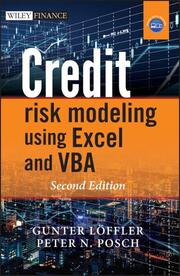-
Zusatztext
-
It is common to blame the inadequacy of credit risk models for the fact that the financial crisis has caught many market participants by surprise. On closer inspection, though, it often appears that market participants failed to understand or to use the models correctly. The recent events therefore do not invalidate traditional credit risk modeling as described in the first edition of the book. A second edition is timely, however, because the first dealt relatively briefly with instruments featuring prominently in the crisis (CDSs and CDOs). In addition to expanding the coverage of these instruments, the book will focus on modeling aspects which were of particular relevance in the financial crisis (e.g. estimation error) and demonstrate the usefulness of credit risk modelling through case studies. This book provides practitioners and students with an intuitive, hands-on introduction to modern credit risk modelling. Every chapter starts with an explanation of the methodology and then the authors take the reader step by step through the implementation of the methods in Excel and VBA. They focus specifically on risk management issues and cover default probability estimation (scoring, structural models, and transition matrices), correlation and portfolio analysis, validation, as well as credit default swaps and structured finance. The book has an accompanying website, loeffler-posch.com, which has been specially updated for this Second Edition and contains slides and exercises for lecturers.
-
-
Kurztext
-
This book provides practitioners and students with a hands-on introduction to modern credit risk modeling. The authors begin each chapter with an accessible presentation of a given methodology, before providing a step-by-step guide to implementation methods in Excel and Visual Basic for Applications (VBA). The book covers default probability estimation (scoring, structural models, and transition matrices), correlation and portfolio analysis, validation, as well as credit default swaps and structured finance. Several appendices and videos increase ease of access. The second edition includes new coverage of the important issue of how parameter uncertainty can be dealt with in the estimation of portfolio risk, as well as comprehensive new sections on the pricing of CFSs and CDOs, and a chapter on predicting borrower-specific loss given default with regression models. In all, the authors present a host of applications - many of which go beyond standard Excel or VBA usages, for example, how to estimate logit models with maximum likelihood, or how to quickly conduct large-scale Monte Carlo simulations. Clearly written with a multitude of practical examples, the new edition of Credit Risk Modeling using Excel and VBA will prove an indispensable resource for anyone working in, studying or researching this important field. Praise for the first edition "In one place, Löffler and Posch provide all that is needed to install a state-of-the-art risk management system, including a broad understanding of different risk management frameworks, detailed estimation techniques for dertiving PD, LGD, and correlation parameters, and programming tools for putting thesr methods into practice." - Richard Cantor, Chief Credit Officer, Moody's Investor Service
-
-
Autorenportrait
- Gunter Löffler is Professor of Finance at the University of Ulm in Germany. His current research interests are on credit risk and empirical finance. Previously, Gunter was Assistant Professor at Goethe University Frankfurt, and served as an internal consultant in the asset management division of Commerzbnk, His Ph.D. in finance is from the University of Mannheim. Gunter has studied at Heidelberg and Cambridge Universities. Peter N. Posch is Assistant Professor of Finance at the University of Ulm in Germany. Previously Peter was co-head of credit treasury at a large bank, where he also traded credit derivatives and other fixed income products for the bank's proprietary books. His Ph.D. in finance on the dynamics of credit risk is from the University of Ulm. Peter has studied economics, philosophy and law at the University of Bonn.
Detailansicht
Credit Risk Modeling using Excel and VBA
Wiley Finance Series
ISBN/EAN: 9780470660928
Umbreit-Nr.: 1609606
Sprache:
Englisch
Umfang: 358 S.
Format in cm: 2.5 x 25 x 17.5
Einband:
gebundenes Buch
Erschienen am 17.12.2010
Auflage: 2/2010


